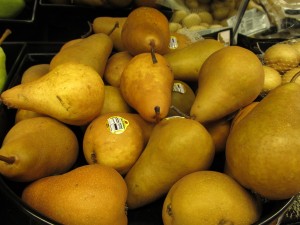Growing pears in the Southeastern U.S. is both challenging and rewarding. Both the European (Pyrus communis) and Asian (P. pyrifera) pears are susceptible to fireblight (Erwinia amylovora), a bacterial disease with no satisfactory cure. Two popular European pear varieties, ‘Bartlett’ and ‘Bosc’, are highly susceptible to fireblight. Varieties found to be fire blight resistant are: ‘Warren’, ‘Aires’, and ‘Moonglow’. ‘Shinto’ is an Asian pear variety with crispy russet brown fruits and possesses above average fireblight resistance.
European pears are unique in that the fruits do not ripen on the tree. Fruits must be harvested on a scheduled date for each variety and ripened indoors. The unripened pears are stored in a closed plastic or paper bag (sack) for 7-10 days at room temperature (60-70 °F). Fruits are then refrigerated to slow down ripening.
Asian pears ripen on the tree like apples, and are ready to eat when harvested. Asian pears are picked from late August to early October, depending on the variety grown.
European pear varieties will not pollinate Asian pears. Asian pears tend to bloom several days later than European varieties. Both European and Asian pears also require cross-pollination of two different varieties.
Both European and Asian pears are notorious for “biennial bearing”. A tree may overproduce one year, and yield a small crop the next (the ‘off” year). Biennial bearing in the “on” year often results in limb breakage and smaller fruits. To prevent or break the biennial bearing cycle, remove excess fruits by hand within 30 days after full bloom in the “on” year. As a rule, one pear fruit is supported by 30-40 leaves.


 Posted in
Posted in 
